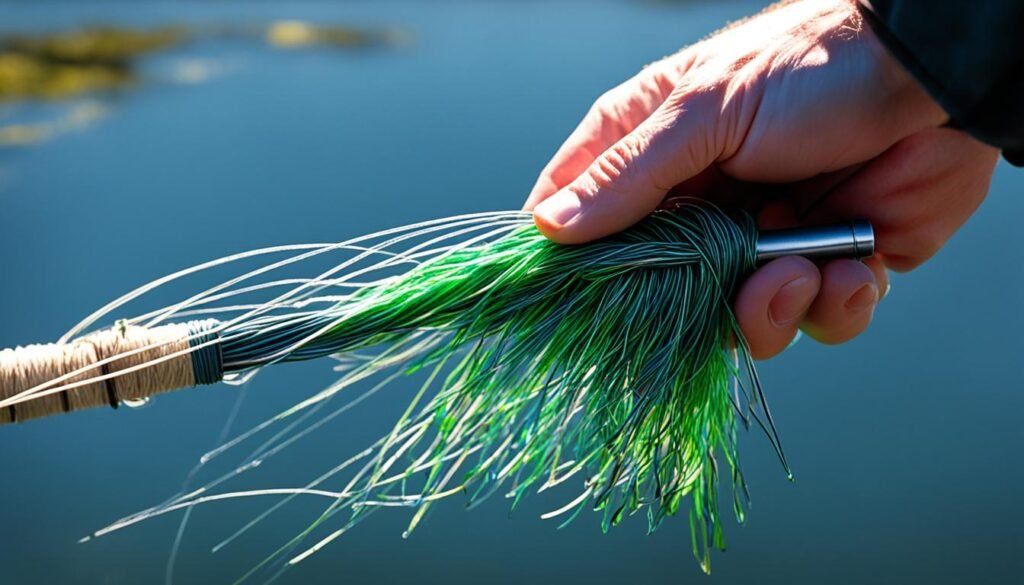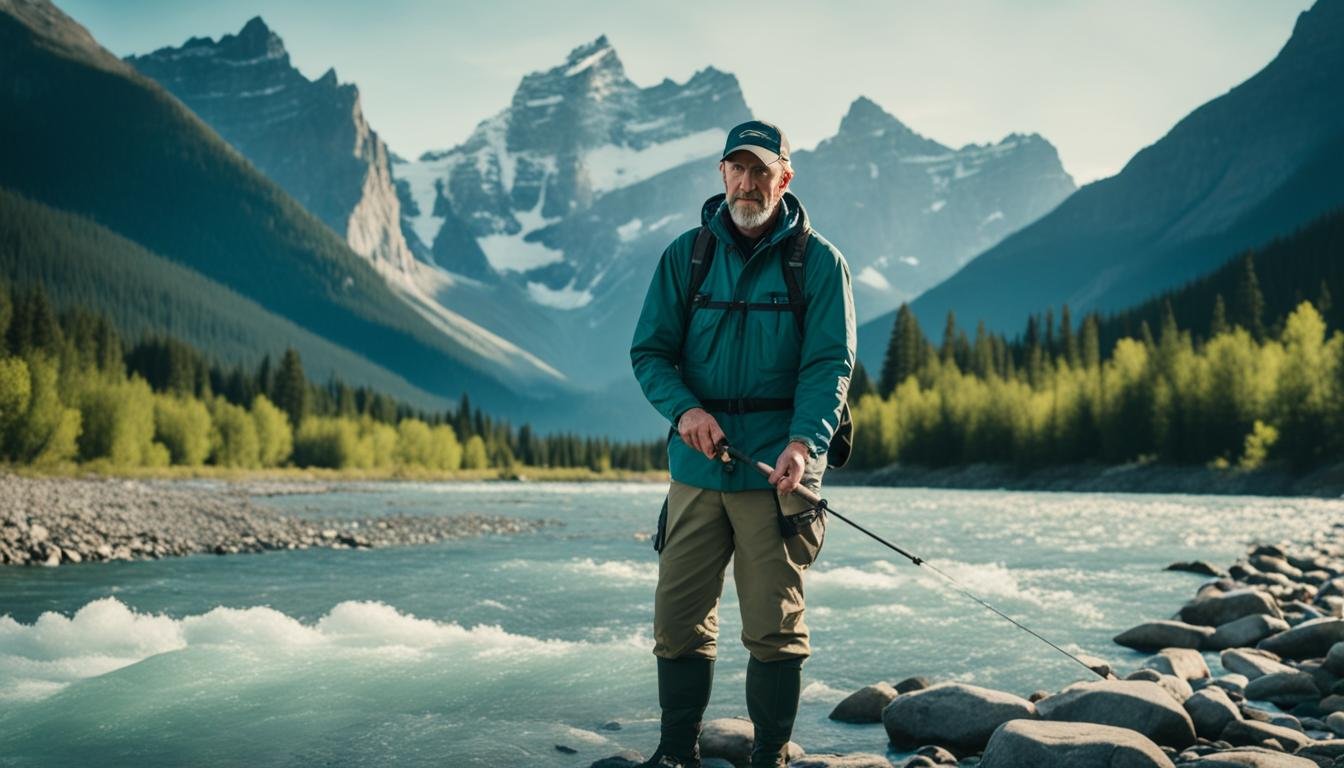Ready to dive into Canadian fishing?
This guide will help you master angling basics. You’ll learn essential techniques and gain confidence in your fishing skills.
We’ll cover fishing gear, casting, and knot tying. You’ll discover proven methods to catch more fish. We’ll also explore Ontario’s fish species and fishing rules.
Key Takeaways about Beginner Fishing Techniques
- Understand the basic fishing gear essentials for Canadian waters
- Learn effective casting and knot tying techniques to improve your fishing
- Discover the most common fish species in Ontario and how to identify them
- Familiarize yourself with the fishing regulations and licensing requirements in Canada
- Explore proven techniques and strategies to increase your chances of a successful catch
Fishing Gear Essentials
The right fishing gear is vital for beginners in Canada. This section covers essential components for getting started. We’ll explore rods, reels, lines, and tackle.
Rods, Reels, and Lines
Your rod, reel, and line choice can greatly affect fishing success. Beginners often find spinning rod and reel combos user-friendly. Consider rod and reel selection with 4 to 6-foot lengths for light fishing.
Entry-level spinning reels offer necessary functionality and ease of use. For fishing lines, monofilament, fluorocarbon, and braided line are common options. Monofilament is versatile, while fluorocarbon improves visibility and abrasion resistance.
Master line spooling to ensure your reel performs optimally. This skill is crucial for proper reel loading and better fishing results.
Tackle and Accessories
Beginner anglers need the right fishing tackle. This includes hooks, floats, weights, and various bait and lures. Choose tackle based on target species and fishing conditions.
- Hooks vary in sizes and styles, from basic bait hooks to specialized options for natural bait or soft-plastic bait.
- Floats, or bobbers, keep bait at desired depths and show when fish bite.
- Weights, or sinkers, help cast further and keep bait near the bottom.
- A diverse selection of lures, including spoons, crankbaits, and soft-plastics, can target various fish species effectively.
Understanding essential fishing gear boosts success chances for beginners. Proper use of this equipment enhances the overall fishing experience. With practice, you’ll become more skilled in using your gear.
Casting and Knot Tying

Casting and knot tying are key skills for anglers. Let’s explore spinning rod casting and the Palomar knot. These techniques will boost your fishing success.
Perfecting Your Cast
Casting with a spinning rod needs smooth, controlled motion. Hold the rod with your dominant hand near the reel. Place your other hand on the foregrip.
Lift the rod tip and let the lure’s weight load the rod. Smoothly move the rod tip forward, keeping the line parallel to water. Pause briefly at the furthest point before releasing.
Practice will improve your distance and accuracy. Soon, you’ll be casting like a pro.
Tying the Palomar Knot
The Palomar knot is strong and easy to tie. It works well with various line types and tackle.
Thread the line through the hook eye twice, creating a loop. Pass the loop and tag end through the eye again. Cinch the knot tightly.
This simple knot provides a secure connection. It’ll help you land more fish.
These skills will improve your fishing experience. Practice casting and knot tying regularly. You’ll become a more confident and successful Canadian angler.
Beginner Fishing Techniques
Fishing for beginners can be thrilling and rewarding. Let’s explore bait fishing and lure fishing. These basics will help you approach the water confidently.
Bait Fishing
Bait fishing uses natural or artificial baits to attract fish. Learn proper rigging techniques to start. Attach a hook to your line and secure the bait.
Live worms, minnows, or soft-plastic baits work well for new anglers. These choices can increase your chances of a successful catch.
Lure Fishing
Lure fishing offers a more active experience. Lures mimic natural prey, triggering fish to strike. Try spinnerbaits, crankbaits, and topwater plugs in your local waters.
Practice catch and release to ensure sustainable fisheries. Handle fish carefully and release them quickly. This approach helps preserve fish populations for future anglers.
Stay safe while fishing. Always wear a Coast Guard-approved flotation device when wading or boating. With the right gear and mindset, you’ll become a confident angler.
| Fishing Technique | Key Considerations |
|---|---|
| Bait Fishing |
|
| Lure Fishing |
|
| Catch and Release |
|
“The secret to successful fishing often lies in the details – from the right bait to the proper technique. As a beginner, embrace the learning process and have patience with yourself. The rewards of mastering these skills will make every catch all the more satisfying.”
Fishing Tips and Strategies

When and Where to Fish
Timing and location are crucial for successful fishing. Many fish are more active during early morning and late afternoon. Tides and currents impact feeding behavior, especially in saltwater environments.
Knowing how to read tides and identify prime feeding times gives anglers an advantage. Look for areas with weed beds, rocky structures, or woody debris that attract fish.
In flowing water, trout often prefer calmer pools and runs created by boulders or fallen trees. Backwaters and sloughs in rivers can be excellent fishing spots, particularly in warmer regions.
Lure Presentation
Properly presenting lures is an important skill to master. Select the right lure colors, sizes, and retrieval methods to improve your success. Try to mimic the natural prey that your target species is feeding on.
Use shiny, silver lures to imitate baitfish or muted colors to match local forage. Experiment with different lure sizes and retrieval techniques for better results.
A slow, steady retrieve may work in some situations. In others, a more erratic, “twitching” action can be effective. Observe how fish react to your lures and adjust your presentation accordingly.
| Lure Color | Lure Size | Lure Retrieve |
|---|---|---|
| Silver, shiny lures for baitfish imitation | Smaller lures for trout and panfish, larger lures for predatory fish | Slow, steady retrieves for calm conditions, erratic “twitching” for active fish |
Patience is key when fishing. Finding the right mix of timing, location, and lure presentation takes practice. The thrill of a successful catch makes it all worthwhile.
For an overview about Fishing for Beginners in Canada, please check this guide.
12 Key Beginner Fishing Techniques and Tips for Canadian Anglers
- Float (bobber) fishing is an excellent technique for beginners, as it’s very visual and helps teach when to set the hook. Seeing the float go down makes it easier to detect bites compared to feeling them[1].
- Spincast and spinning reels are great options for novice anglers. They’re easy to use and can support casting small jigs and lures suitable for panfish, which are ideal starter species[1].
- When introducing someone new to fishing, start with panfish like sunfish or perch. These species can often be found in large numbers in shallow waters during spring, offering plenty of action for beginners[1].
- Match your lure color to the water color. In clear water, use white or pearl lures. For green water, lime or chartreuse colors work well[5].
- Choose lure shapes and sizes that mimic the local baitfish. This “match the hatch” approach can significantly improve your chances of success[5].
- Fish early in the morning or late in the evening. Many fish species are more active during these times, especially in summer when they seek cooler water[5].
- For saltwater fishing in Canada, pay attention to tides and currents. These factors greatly influence fish behavior and feeding patterns[5].
- Always use sharp hooks. Dull hooks significantly reduce your chances of successfully landing fish. Replace old hooks or sharpen them regularly[5].
- Set your reel’s drag properly using a scale. The drag should be set to one-third of the line’s rated breaking strength for optimal performance[5].
- Consider taking a Learn to Fish program offered by parks or local organizations. These programs provide hands-on instruction and often supply equipment, making them perfect for beginners[1].
- When fishing in lakes, try different depths until you find where the fish are active. Use a fish finder if available to locate schools of fish[3].
- For fly fishing beginners in Canada, start with a 6-weight rod for trout and steelhead, or an 8-weight rod for salmon. The Great Lakes, British Columbia, and Prince Edward Island offer excellent fly fishing opportunities[3].
Remember to obtain the necessary fishing licenses before heading out, as they’re required in most Canadian fishing locations[3]. By following these techniques and tips, new Canadian anglers can increase their chances of success and enjoyment on the water.
Citations:
[1] https://www.ontarioparks.ca/parksblog/7-tips-for-introducing-newcomers-to-fishing/
[2] https://www.destinationontario.com/en-ca/articles/fishing-for-beginners-ontario
[3] https://fishingbooker.com/blog/canada-fishing/
[4] https://trailerparkscanada.com/beginners-fishing-gear-checklist/
[5] https://www.discoverboating.com/resources/how-to-fish-beginner-fishing-tips
Conclusion
Knowing fishing rules in Canadian waters is vital. These cover size limits, catch quotas, and conservation measures. They ensure Ontario’s fisheries remain sustainable for years to come.
Identifying fish species helps you follow regulations. It also aids in making responsible angling choices. This knowledge is key to successful fishing.
Catch-and-release is a cornerstone of ethical fishing. Handling fish carefully and returning them to water preserves healthy populations. This practice shows respect for aquatic ecosystems.
Many resources are available to improve your fishing skills. These include regulations, species guides, and technique tutorials. Use them to enhance your angling experience.
Explore new fishing spots and enjoy the art of angling. A rewarding and sustainable fishing adventure awaits you on the water.
FAQs about Beginner Fishing Techniques
What are the simple fishing techniques?
Simple fishing techniques include bait fishing, casting, and jigging. For ice fishing, using a jig and minnow with a 20-inch medium or light-action ice fishing rod is a straightforward technique. Setting up tip-ups or using a rod holder are also simple methods for beginners.
How to catch a fish for beginners?
For beginners, start with the right equipment like a basic rod and reel combo. Use appropriate bait or lures for your target species. In ice fishing, for example, hook a minnow just under the dorsal fin and let the line out until you feel the jig hit the bottom. Jig the bait up and down, keeping it close to the lake floor. When you feel a fish tap 2-3 times, let it take the rod down 8-10 inches before setting the hook.
What type of fishing is best for beginners?
Shore fishing, dock fishing, and fishing in calm waters like ponds and lakes are ideal for beginners. Ice fishing can also be beginner-friendly, especially with a heated fishing shack. Fly fishing and deep sea fishing are also options, but might require more experience or guidance from a professional.
What is the secret to fishing?
The “secret” to fishing involves understanding fish behavior and habitat, using the right bait or lure, paying attention to weather and water conditions, and practicing proper techniques. Patience is key, as is persistence in trying different spots and methods. For ice fishing specifically, knowing how to present your bait naturally and understanding how fish behave in cold water conditions can greatly improve your chances of success.
What equipment do I need to get started with fishing?
Beginners need a fishing rod, reel, line, and essential tackle. This includes hooks, floats, weights, and bait or lures. Our guide explains different types of gear to help you choose wisely.
How do I learn proper casting and knot tying techniques?
Casting and knot tying are key fishing skills. We offer step-by-step instructions for casting with a spinning rod. You’ll also learn to tie the Palomar knot, a strong and simple option.
What are the different fishing techniques I should know as a beginner?
Our guide covers bait fishing basics, including rigging natural and soft-plastic baits. It also explains how to cast and work lures effectively. We emphasize catch-and-release practices for conservation.
How do I choose the best times and locations to go fishing?
Timing and location are crucial for fishing success. We explore the best times to target certain species. You’ll learn how tides and currents affect feeding patterns in saltwater.
We also guide you in finding productive fishing spots. These include weed beds, rocky structures, and other key habitat features.
What do I need to know about lure presentation and selection?
Proper lure presentation is a vital angling skill. We cover how to select lure colors, sizes, and retrieval techniques. You’ll learn to match lures to water conditions and natural prey.
What fishing regulations and species identification do I need to be aware of?
Canadian fishing requires knowledge of regulations covering size limits and catch quotas. It’s crucial to identify fish species correctly to follow these rules.
Source Links
- http://www.ontario.ca/page/learn-fish-guide
- https://www.discoverboating.com/resources/how-to-fish-beginner-fishing-tips
- https://bushlife.ca/fishing/
- https://www.takemefishing.org/how-to-fish/fishing-resources/everything-you-need-to-start-fishing/
- https://www.outsideonline.com/outdoor-adventure/water-activities/how-to-start-fishing/
- https://www.gofishbc.com/learn/fishing-tips/lake-fishing/beginners-guide-to-fishing-rods-tackle/
- https://wildlife.utah.gov/news/wildlife-blog/1752-learn-to-fish-casting-line-and-catching-fish.html
- https://drifthook.com/blogs/discover/10-fly-fishing-casting-tips-for-beginners
- https://fishingbooker.com/blog/how-to-tie-fishing-knots/
- https://www.fws.gov/story/guide-fishing-first-time
- https://www.bigfishtackle.com/fishing-tips-for-beginners-immediate-and-advanced/
- https://fishingbooker.com/blog/fishing-tips-for-beginners/
- https://www.takemefishing.org/how-to-fish/fishing-tips/fishing-tips-for-beginners/
- https://www.gofishbc.com/learn/fishing-tips/lake-fishing/lake-fishing-techniques-for-beginners/
- https://www.campspot.com/camp-guide/fishing-tips-for-beginners
- https://www.matthewdavies.com/fishing-tips-and-tricks-for-beginners/
- https://hawkeyeelectronics.com/blogs/boating-fishing-electronics-blog/different-angling-techniques-for-beginners-and-pros
- https://inthespread.com/blog/master-any-fish-beginner-to-pro-guide-328


